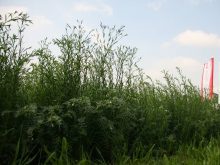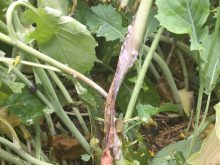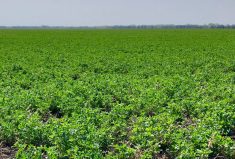Reducing and/or preventing yield losses caused by sclerotinia in canola takes a multi-pronged approach, says a research scientist with Corteva Agriscience.
Scott McClinchey, a canola breeder based in Guelph, Ont., says farmers can’t change the weather but they do have other measures within their control to help minimize the effect of the disease on their crops, which in severe cases can result in as much as 50 per cent yield loss.
“We develop new varieties with a great deal of potential in terms of yield and with traits such as disease resistance,” says McClinchey. “But it is important through proper management to protect that yield potential as much as possible.”
Read Also

Cancer agency reclassifies another herbicide ‘probably carcinogenic’
The WHO’s cancer research agency has now put atrazine, a herbicide well known to corn growers, in the same potential-hazard category where the agency put glyphosate.
Now the 2022 canola crop is the bin, the coming months are a good time to get plans in place for the 2023 cropping season. McClinchey says some things to consider are figuring out a rotation that optimizes the break between canola crops, lining up seed for sclerotinia-resistant canola varieties and making plans to apply a fungicide if growing conditions warrant.
Growing canola in a proper rotation with other crops is one important aspect of disease management, says McClinchey. Developing a rotation that leaves a two- or three-year break or more between canola crops — for example, canola-corn-cereal or canola-pulse-cereal — helps to reduce the risk of disease development.
Also determine that other crops in the rotation are not susceptible to sclerotinia, such as dry beans or sunflower, as they can add to the level of disease load in the field. Keep in mind too the sclerotia bodies from sclerotinia can survive in the soil for up to seven years.

Varieties with sclertoinia resistance
On the plant breeding front, McClinchey says it takes a lot of work over a number of years to develop varieties with disease resistance. Corteva has three hybrid canola varieties with sclerotinia resistance.
“One important tool in reducing the risk of losses due to disease is to grow a resistant variety,” says McClinchey. “Varieties with disease resistance can reduce sclerotinia incidence by over 65 per cent.”
New hybrid varieties are developed with multiple or “stacked” traits to improve the overall performance of the variety on several fronts. As Corteva develops new lines of canola, they are put through rigorous testing at disease nurseries. High levels of disease pressure are applied to select those lines that show the highest disease resistance.
Within Corteva’s Brevant seed line, B3014 is a newer LibertyLink canola hybrid that combines sclerotinia, clubroot and blackleg resistance in a high-yielding package. Within Corteva’s Pioneer brand, P505MSL is a newer LibertyLink hybrid with a high rating for sclerotinia resistance and resistance to clubroot, blackleg and fusarium wilt. And producers may be familiar with a slightly older Pioneer variety 45CS40, a Roundup Ready canola hybrid developed with sclerotinia, blackleg and clubroot resistance.
McClinchey says while selecting varieties with sclerotinia resistance is an important step in protecting the crop, it does not provide a 100 per cent guarantee against disease loss. Depending on growing conditions and disease severity, applying a fungicide such as Acapela (the active ingredient is picoxystrobin) might also be required.
“The issue with sclerotinia and some other diseases is if you see signs of disease on the crop it is too late to apply a fungicide,” says McClinchey. “So producers need to be proactive, assess their disease risk and decide if a fungicide is warranted.”
Under dry growing conditions, disease risk might be quite low, while under warm, moist growing conditions the risk could be quite high. A fungicide application might be good insurance against disease loss, McClinchey says.

Corteva grower information says infection occurs during flowering from airborne spores and is highly dependent on weather conditions at the time of infection. Wet conditions, moist soil, high humidity and temperatures between 15 C and 25 C within the crop canopy are conducive to sclerotia germination. Once infected, the disease can cause lesions, bleached and weak stems, premature ripening, crop lodging and reduced yields from fewer pods and seeds.
Here are some of the factors during a growing season that can point toward the need for a fungicide application:
- Warm soil temperatures throughout June and early July.
- Soil moisture at or near field capacity throughout June and up to flowering.
- The presence of sclerotinia in previous years.
- High humidity levels in the canopy and moisture on the plants, allowing for “petal stick.”
- Frequent showers and moderate temperatures in July.
- Rainfall (at least five to 10 millimetres) on more than two days per week.
- The crop canopy is wet throughout most of the day.
- Temperatures during the day and night are warm rather than cool.
As a general rule, canola yield loss due to sclerotinia will be about 50 per cent of the disease infection level. When deciding to use a fungicide, it’s important to consider the economics.
Corteva offers the following example. If you estimate 30 per cent of the crop is infected, that translates into about a 15 per cent yield loss. In a 40-bushel crop, that represents a yield loss of about six bushels per acre, which at a market value of $20 per bushel means a $120-per-acre revenue loss. If the cost of fungicide application was $30 per acre, then spraying a fungicide for sclerotinia control would be very economical in this example.
Agronomic improvements
McClinchey says while it can be a challenge to introduce disease resistance into new varieties and still maintain or perhaps improve many other desirable traits, progress continues to be made in developing improved canola varieties.
McClinchey says Corteva’s breeding program is always looking to improve quality and agronomic characteristics of new varieties. Increased yield is always on the shopping list, along with improved disease resistance and other traits such as shatter resistance.
“We have a very dedicated team working on the breeding program to produce improved varieties,” says McClinchey. “And we are proud of the progress we have made in recent years in bringing some very competitive hybrid varieties to the market. It is all part of bringing increased value and profitability to Canadian farmers.
“Shatter resistance is an important feature that helps protect the value of that canola crop,” he adds. McClinchey welcomes the creation of a new industry-wide rating system for shatter resistance that makes it easier for farmers to compare shatter resistance levels among different varieties.
Developed in a co-operative effort by the canola industry and introduced in 2022, the system rates pod shatter resistance in canola cultivars on a scale of one to nine. It was designed in part to help canola producers understand their options if they decide to delay harvest — a choice several growers considered in 2021 as the hot, dry growing season extended into harvest time in many parts of the Prairies.
















